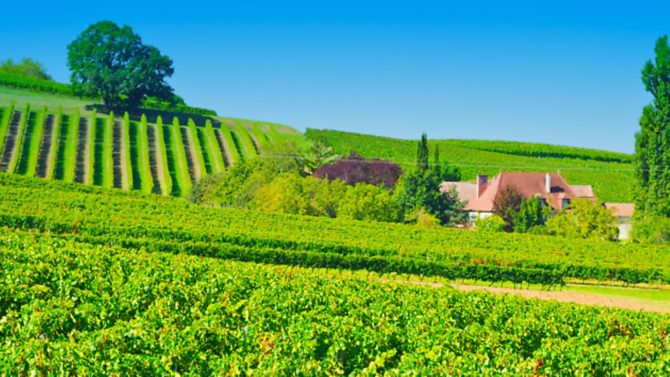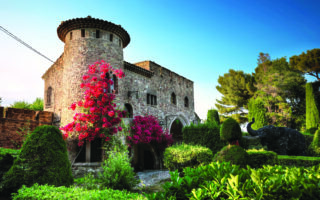Location spotlight: Aquitaine

Characterised by an eclectic mix of sea ports, meandering rivers and world-famous vineyards, Aquitaine also boasts many exceptional homes, as Joanna Leggett discovers

For many, the name Aquitaine seems irrevocably linked to tales of knights in shining armour, wandering minstrels, Richard the Lionheart and, most of all, Eleanor of Aquitaine.
History abounds at every corner but rather than starting with tales of derring-do, the known history of this region actually goes back some 400,000 years earlier.
Along the Vèzere valley are Les Eyzies and Lascaux with pre-historic caves decorated by cro-magnum man. Discovered during the war by children who were playing there, they were closed to all but archealogical experts in the 1960s to protect them from deterioration. However, it is still possible to visit the caves at Lascaux and view an exact facsimile of the wall paintings as they would have been.
Moving on to a mere 2,000 years ago, in marched the Romans who were responsible for introducing vines around Bordeaux, no doubt to serve as digestifs for the many legionnaires based in this part of the country.
They also left remarkable ruins such as Vesunna in Périgueux, the capital of Dordogne. It’s claimed that they were also responsible for introducing foie gras!
Moving on another millenia or so, it was the turn for a British invasion following the marriage of Eleanor of Aquitaine (who had first dumped the French king) with Count Henri Plantagenet who became, within months of their wedding, Henry II of England. Then followed ongoing rampages during the Hundred Years’ War and many villages boast fortified church towers, to which villagers would flee for safety during raids by rampaging Brits. Today, your welcome is likely to be somewhat more gracious.

Fortifed bastide towns are another reminder of this bygone age. Clad in golden stone, these are now enchanting places bedecked in summer with roses and hollyhocks, rather than armed soldiery.
The Périgord, or Dordogne, has perhaps the richest heritage of all as it was the front line of all those medieval wars. Castles were built on rocky outcrops along the river, where armies used enormous and fantastic machines to hurl rocks at each other. Today, they stand peacefully as mellow and picturesque monuments to catch your eye as you meander through the beautiful river valleys which traverse this magic land.
Châteaux are a major feature of this area, ranging from simple fortified towers to the gracious dwellings of the rich and famous, and home to such renowned wine labels as Châteaux Margaux, Haut-Brion, Latour, Lafite-Rothschild and Mouton-Rothschild.
Aquitaine covers a massive area, extending from the Atlantic seaboard through the elegant 18th-century port of Bordeaux, down past the amazing sand dunes which surround Arcachon, through the open spaces of Les Landes, to Bayonne and Biarritz in Basque country with its sandy beaches and surfing waves.
Across its southern extremity is the breathtaking mountain scenery of the Pyrénées, separating France from Spain: skiing, mountaineering, walking and fine dining are some of the ways to while away your time in this particular part of the region.
Flowing from the east are the two great river areas: Lot-et-Garonne is river country par excellence, with miles of cycle tracks, and then there’s the Périgord with the beautiful River Dordogne as well as the lesser-known Canal de Garonne which connects to the Canal du Midi at Toulouse.
Food abounds in glorious quantity and regional specialities include truffles, chestnuts, prunes, wine and the legendary armagnac. And then add to the list Bayonne ham, chocolate (this was one of the first places in Europe where the precious beans were landed, inspiring the film Chocolat), confits of duck and goose, salt-marsh lamb from around Bordeaux and the list goes on. The street markets held throughout the area offer an abundance of seasonal produce.
Bordeaux itself is an elegant university town, said to have inspired Haussmann in his design for the redevelopment of Paris. A thriving seaport for centuries, it is perhaps the most renowned wine-producing area in the world. But when it comes to Aquitaine and wine, there’s more: don’t forget St-Émilion, Bergerac, the Medoc, Jurançon. And then there’s Sauternes – think Château d’Yquem, the classical accompaniment for foie gras or dessert, or choose a Monbazillac which does the same job for a fraction of the price.
All of Aquitaine is blessed by its warm summer climate and it’s often possible to eat outside in a sheltered spot from early March through to the end of October.
No one is in a rush here. Stores, banks and post offices have long daily lunch breaks. People you meet talk about the mushrooms they found in the forest or where the geese are flying. Apparently, it’s an indication of how soon summer will be coming round again.
Village living
When it comes to property, the choice is just as varied. Currently for sale in Périgord Noir (called black because this a truffle-growing area), and not far from the medieval golden stone town of Sarlat, is an extraordinary 12th-century priory in Meyrals, one of the most beautiful villages in France. Retaining many of its original features, with five open fireplaces, chestnut floors and a lauze stone roof, this home has four bedrooms, three bathrooms, a small swimming pool/spa, separate garden, garage and independent courtyard. Stepping from a magical inner courtyard into the typical Périgourdine kitchen, complete with flagstone floor, wooden stairs then lead upstairs to a large L-shaped attic offering scope to further extend the living space. This property comes complete with its own pigeonnier with bread oven and is currently for sale at €604,200.
Business opportunity
Should you be looking to combine work and play, there is currently a splendid 17th-century townhouse in the Dordogne village of St-Cyprien which promises income-generating potential. Boasting seven bedrooms and five bathrooms, there is also a separate studio and spacious outbuilding, charming courtyard and mature gardens. This remarkable property was once a relais on the pilgrim path to Santiago de Compostela and could easily again become a charming chambres d’hôtes. Each of the bedrooms has either its own bathroom or basin and there is space to add two more rooms in the attic. There is even potential to add a pool, while a small garden on the other side of the road provides parking. This home is for sale at €498,200.
Joanna Leggett is marketing director at Leggett Immobilier
Tel: 08700 11 51 51
Share to: Facebook Twitter LinkedIn Email


